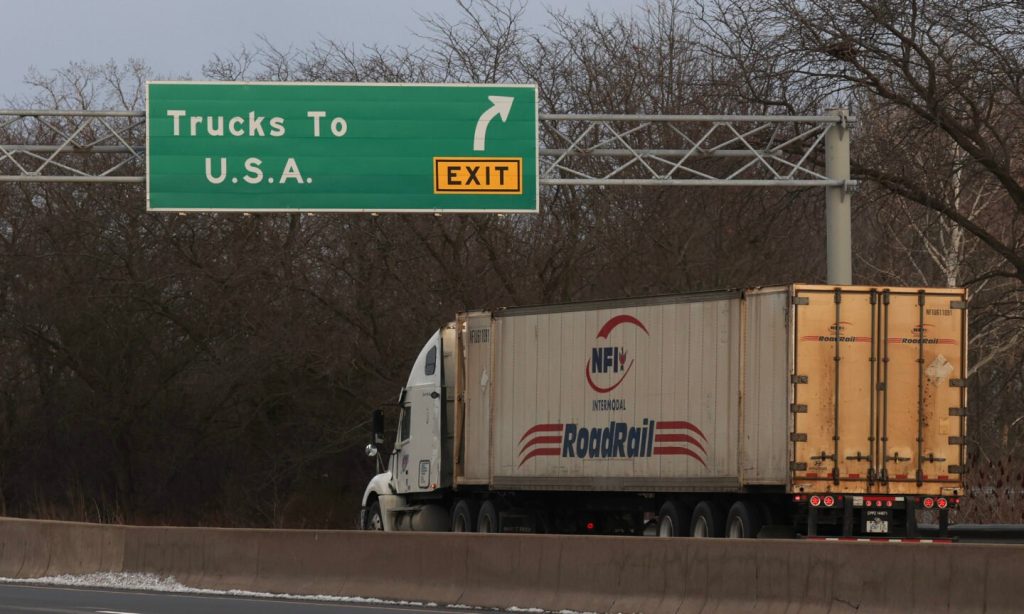Trump’s promised 25% tariffs on Mexico and Canada have gone into effect. An additional 10% tariff has also been levied on Chinese goods, bringing the total added tariff to 20%.
Trump has long said the tariffs are punitive, meant to curb drug trafficking into the United States. He has also claimed they’re meant to entice companies to bring more manufacturing back to the U.S. Following the official start to the tariffs, Trump posted on Truth Social, “If companies move to the United States, there are no tariffs!!!”
How did we get here?
Mexico, Canada and China are the three top trading partners for the U.S. Both Mexico and Canada are more dependent on the U.S. than vice versa, which means the economic impact could be greater to those two countries than to the U.S. China, meanwhile, has the largest share of trading in the world.
On Jan. 31, Trump first announced new tariffs including a 10% tariff on China and a 25% tariff on all goods imported to the U.S. from Mexico and Canada with one exception: Oil from Canada would face a 10% tariff. On Feb. 3, leaders from Canada and Mexico negotiated a one-month delay of the tariffs by promising to beef up border patrol efforts.
But on Feb. 4 the initial 10% tariff on China still went into effect. China responded with retaliatory tariffs ranging from 10% to 15% on a specific set of energy products, cars and agricultural machinery. These tariffs went into effect on Feb. 10.
News moves fast. Stay ahead of how it could impact your money.
Interest rates, inflation, natural disasters — get notified when breaking news could affect your finances, and get expert insights to help you plan your next move.
Then on Feb. 7, Trump suspended tariffs on small packages from China. Prior to the announcement, the United States Postal Service USPS, in order to comply with the sweeping 10% tariff, briefly stopped accepting any packages from China. All packages from China under $800 will be imported tariff-free to the U.S.
On Feb. 1, Canada announced retaliatory tariffs. But following a call with Trump days later, Canadian President Justin Trudeau said Canada’s tariff on the U.S. would also be pushed back by one month.
What happens next?
Canada has already enacted retaliatory 25% tariffs on C$155 billion ($107 billion) of U.S. products. Tariffs on C$30 billion of U.S. goods began on Tuesday and the remaining tariffs on an additional C$125 billion will begin in 21 days.
Mexico President Claudia Sheinbaum said that Mexico will announce its own retaliatory tariffs on March 9.
China retaliated with tariffs on agricultural imports from the U.S. That includes 15% tariffs on chicken, wheat, corn and cotton imports. There will also be 10% tariffs on sorghum, soybeans, pork, beef, aquatic products, fruits, vegetables and dairy products. The tariffs will begin on March 10.
Retaliatory tariffs would increase prices on goods imported from the U.S. and could potentially lead to a trade war.
Estimates by Peterson Institute for International Economics (PIIE) show 25% tariffs on Mexico and Canada would slow growth and accelerate inflation. U.S. consumers would see prices rise on goods coming from those countries. Consumers would also see higher prices for goods manufactured in the U.S. that require supplies from those countries.
The Observatory of Economic Complexity (OEC) which supplies global trade data, says the chief products that Mexico exports to the U.S. are computers, cars, as well as motor vehicles, parts and accessories. The U.S. exports mainly refined petroleum, motor vehicle parts and accessories, as well as petroleum gas to Mexico.
Canada primarily exports crude petroleum, cars and petroleum gas to the U.S. Meanwhile, the U.S. mainly exports cars, refined petroleum and delivery trucks to Canada.
China exports a wide variety of products and supplies to the U.S. including telephones, computers, electric batteries, light fixtures and motor vehicle parts, and accessories. The U.S. mainly exports soybeans, cars, petroleum gas, integrated circuits and crude petroleum to China.
More tariffs are on the way
Trump has planned three other tariffs that would be placed on all nations including a 25% tariff on aluminum and steel (March 12) and an unspecified tariff on all foreign cars (April 2).
On March 4, Trump signaled that he was cooking up a new agriculture tariff. He posted on Truth Social, “To the Great Farmers of the United States: Get ready to start making a lot of agricultural product to be sold INSIDE of the United States. Tariffs will go on external product on April 2nd. Have fun!” Trump did not indicate what agricultural products could be impacted.
Previous tariff news
Feb. 11: New steel and aluminum tariffs announced
Jan. 27: Trump floats tariffs on steel, semiconductors, pharmaceuticals
Jan. 20: Trump orders trade agreement review
(Photo by Joe Raedle/Getty Images for Getty News Images)

